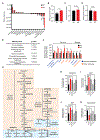SIRT4 loss reprograms intestinal nucleotide metabolism to support proliferation following perturbation of homeostasis
- PMID: 38507411
- PMCID: PMC11639042
- DOI: 10.1016/j.celrep.2024.113975
SIRT4 loss reprograms intestinal nucleotide metabolism to support proliferation following perturbation of homeostasis
Abstract
The intestine is a highly metabolic tissue, but the metabolic programs that influence intestinal crypt proliferation, differentiation, and regeneration are still emerging. Here, we investigate how mitochondrial sirtuin 4 (SIRT4) affects intestinal homeostasis. Intestinal SIRT4 loss promotes cell proliferation in the intestine following ionizing radiation (IR). SIRT4 functions as a tumor suppressor in a mouse model of intestinal cancer, and SIRT4 loss drives dysregulated glutamine and nucleotide metabolism in intestinal adenomas. Intestinal organoids lacking SIRT4 display increased proliferation after IR stress, along with increased glutamine uptake and a shift toward de novo nucleotide biosynthesis over salvage pathways. Inhibition of de novo nucleotide biosynthesis diminishes the growth advantage of SIRT4-deficient organoids after IR stress. This work establishes SIRT4 as a modulator of intestinal metabolism and homeostasis in the setting of DNA-damaging stress.
Keywords: CP: Cancer; SIRT4; glutamine; intestinal organoids; irradiation; nucleotide biosynthesis; nucleotide metabolism; sirtuin.
Copyright © 2024 The Authors. Published by Elsevier Inc. All rights reserved.
Conflict of interest statement
Declaration of interests M.C.H. received research funding from Agilent Technologies and Roche Pharmaceuticals. M.C.H. serves on the scientific advisory boards of Alixia, Minovia, and MitoQ and is on the editorial boards of Cell Metabolism and Molecular Cell. S.V. served as a Cell Reports editor between 2018 and 2021 and is currently the lead editor for Cell Press Multi-Journal Submission. She carried out the work reported in this paper before joining Cell Press. She was not given access to information related to the peer review of this paper, nor did she participate in the decision-making process. K.M.H. received research funding from Novartis and TUO Therapeutics.
Figures





Similar articles
-
SIRTifying intestinal nucleotide metabolism.Trends Endocrinol Metab. 2024 Sep;35(9):763-764. doi: 10.1016/j.tem.2024.07.003. Epub 2024 Jul 20. Trends Endocrinol Metab. 2024. PMID: 39034176
-
SIRT4 protein suppresses tumor formation in genetic models of Myc-induced B cell lymphoma.J Biol Chem. 2014 Feb 14;289(7):4135-44. doi: 10.1074/jbc.M113.525949. Epub 2013 Dec 24. J Biol Chem. 2014. PMID: 24368766 Free PMC article.
-
MET Signaling Mediates Intestinal Crypt-Villus Development, Regeneration, and Adenoma Formation and Is Promoted by Stem Cell CD44 Isoforms.Gastroenterology. 2017 Oct;153(4):1040-1053.e4. doi: 10.1053/j.gastro.2017.07.008. Epub 2017 Jul 14. Gastroenterology. 2017. PMID: 28716720
-
Organoids as a Model System for Studying Notch Signaling in Intestinal Epithelial Homeostasis and Intestinal Cancer.Am J Pathol. 2022 Oct;192(10):1347-1357. doi: 10.1016/j.ajpath.2022.06.008. Epub 2022 Jun 22. Am J Pathol. 2022. PMID: 35752229 Free PMC article. Review.
-
Glutamine and nucleotide metabolism within enterocytes.JPEN J Parenter Enteral Nutr. 1998 Mar-Apr;22(2):105-11. doi: 10.1177/0148607198022002105. JPEN J Parenter Enteral Nutr. 1998. PMID: 9527969 Review.
Cited by
-
Sirtuins and Gut Microbiota: Dynamics in Health and a Journey from Metabolic Dysfunction to Hepatocellular Carcinoma.Cells. 2025 Mar 20;14(6):466. doi: 10.3390/cells14060466. Cells. 2025. PMID: 40136715 Free PMC article. Review.
-
Targeting sirtuins for cancer therapy: epigenetics modifications and beyond.Theranostics. 2024 Oct 14;14(17):6726-6767. doi: 10.7150/thno.100667. eCollection 2024. Theranostics. 2024. PMID: 39479446 Free PMC article. Review.
-
Transcriptomic and metabolomic analysis of the antibacterial mechanism of sanguinarine against Enterobacter cloacae in vitro.BMC Microbiol. 2025 May 6;25(1):269. doi: 10.1186/s12866-025-03992-8. BMC Microbiol. 2025. PMID: 40329217 Free PMC article.
-
Mechanisms and therapeutic opportunities in metabolic aberrations of diabetic wounds: a narrative review.Cell Death Dis. 2025 Apr 25;16(1):341. doi: 10.1038/s41419-025-07583-3. Cell Death Dis. 2025. PMID: 40280905 Free PMC article. Review.
-
Mitochondrial Sirtuins in Cancer: A Revisited Review from Molecular Mechanisms to Therapeutic Strategies.Theranostics. 2024 May 11;14(7):2993-3013. doi: 10.7150/thno.97320. eCollection 2024. Theranostics. 2024. PMID: 38773972 Free PMC article. Review.
References
Publication types
MeSH terms
Substances
Grants and funding
LinkOut - more resources
Full Text Sources
Molecular Biology Databases
Miscellaneous

